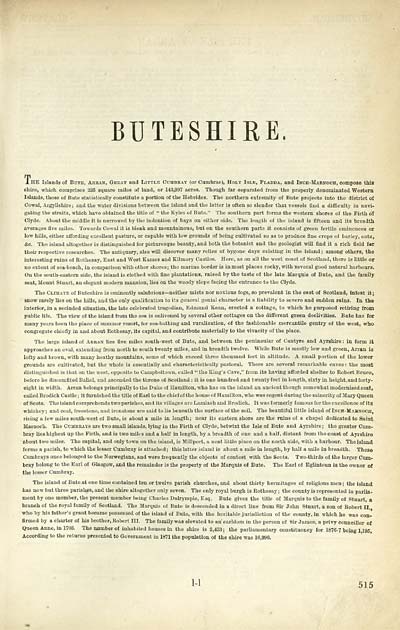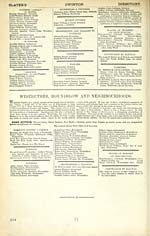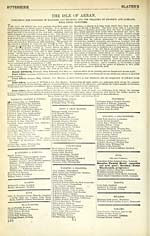Scotland > 1868, 1878 - Slater's (late Pigot & Co.'s) Royal national commercial directory and topography of Scotland > 1878 > Part 1
(593)
Download files
Complete book:
Individual page:
Thumbnail gallery: Grid view | List view

BUTESHIRE.
XHE Islands of Bute, Arran, Great and Little Cumbray (or Cumbrae), Holy Isle. Pladda, and Inch-Marnooh, compose this
sliire, wbicli comprises 225 square miles of land, or 143,997 acres. Though far separated from the properly denominated Western
Islands, those of Bute statistically constitute a portion of the Hebrides. The northern extremity of Bute projects into the district of
Cowal, Argyllshire; and the water divisions between the island and the latter is often so slender that vessels find a difficulty in navi-
gating the straits, which have obtained the title of " the Kyles of Bute." The southern part forms the western shores of the Firth of
Clyde. About the middle it is narrowed by the indention of bays on either side. The length of the island is fifteen and its breadth
averages five miles. Towards Cowal it is bleak and mountainous, but on the southern parts it consists of green fertile eminences or
low hills, either affording excellent pasture, or capable with low grounds of being cultivated so as to produce fine crops of barley, oats,
&c. The island altogether is distinguished for picturesque beauty, and both the botanist and the geologist will find it a rich field for
their respective researches. The antiquary, also will discover many relics of bygone days existing in the island; among others, the
interesting ruins of Rothesay, East and West Karnes and Kilmory Castles. Here, as on all the west coast of Scotland, there is little or
no extent of sea-beach, in comparison with other shores ; the marine border is in most places rocky, with several good natural harbours.
On the south-eastern side, the island is clothed with fine plantations, raised by the taste of the late Marquis of Bute, and the family
seat, Mount Stuart, an elegant modem mansion, lies on the woody slope facing the entrance to the Clyde.
The Climate of Buteshire is eminently salubrious— neither mists nor noxious fogs, so prevalent in the east of Scotland, infest it;
snow rarely lies on the hills, and the only qualification to its general genial character is a liability to severe and sudden rains. In the
interior, in a secluded situation, the late celebrated tragedian, Edmund Kean, erected a cottage, to which he purposed retiring from
public life. The view of the island from the sea is enlivened by several other cottages on the different green declivities. Bute has for
many years been the place of summer resort, for sea-bathing and ruralization, of the fashionable mercantile gentry of the west, who
cougi'egate chiefly in and about Rothesay, its capital, and contribute materially to the vivacity of the place.
The large island of Arran lies five miles south-west of Bute, and between the peninsular of Cantyre and Ayrshire : in form it
approaches an oval, extending from north to south twenty miles, and in breadth twelve. While Bute is mostly low and green, Arran ig
lofty and brown, with many heathy mountains, some of which exceed three thousand feet in altitude. A small portion of the lower
grounds are cultivated, but the whole is essentially and characteristically pastoral. There are several remarkable caves : the most
distinguished is that on the west, opposite to Campbeltown, called " the King's Cave," from its having afforded shelter to Robert Bruce,
before he discomfited BaHol, and ascended the tbrone of Scotland: it is one hundi-edand twenty feet in length, sixty in height, and forty-
eight in width. Arran belongs principally to the Duke of Hamilton, who has on the island an ancient though somewhat modernised seat,
called Brodick Castle ; it furnished the title of Earl to the chief of the house of Hamilton, who was regent during the minority of Mai-y Queen
of Scots. The island comprehends two parishes, and its villages are Lamlash and Brodick. It was formerly famous for the excellence of its
whiskey ; and coal, freestone, and ironstone are said to lie beneath the surface of the soil. The beautiful little island of Inch-Mabnoch,
rising a few miles south-west of Bute, is about a mile in length; near its eastern shore are the ruins of a chapel dedicated to Saint
Marnoch. The Cdmbrats are two small islands, lying in the Firth of Clyde, betwixt the Isle of Bute and Ayrshire; the gi-eater Cum-
bray lies highest up the Firth, and is two miles and a half in length, by a breadth of one and a half, distant from the coast of Ayrshire
about two miles. The capital, and only town on the island, is Millport, a neat little place on the north side, with a harbour. The island
forms a parish, to which the lesser Cumbray is attached ; this latter island is about a mile in length, by half a mile in breadth. These
Cumbrays once belonged to the Norwegians, and were frequently the objects of contest with the Scots. Two-thirds of the larger Cum-
bray belong to the Earl of Glasgow, and the remainder is the property of the Marquis of Bute. The Earl of Eglintoun is the owner of
the lesser Cumbray,
The island of Bute at one time contained ten or twelve parish churches, and about thirty hermitages of religious men; the island
has now but three parishes, and the shire altogether only seven. The only royal burgh is Rothesay ; the county is represented in parlia-
ment by one member, the present member being Charles Dalrymple, Esq. Bute gives the title of Marquis to the family of Stuart, a
branch of the royal family of Scotland. The Marquis of Bute is descended in a direct line fi-om Sii- John Stuart, a son of Robert II.
who by his father's gi'ant became possessed of the island of Bute, with the heritable jurisdiction of the county, in which he was con-
firmed by a chai-ter of his brother, Robert III. The family was elevated to an earldom in the person of Su: James, a privy councillor of
Queen Anne, in 1703. The number of inhabited houses in the shire is 2,433; the parhamentary constituency for 1876-7 being 1,195,
According to the returns presented to Government in 1871 the population of the shire was 16,996.
1-1 515
XHE Islands of Bute, Arran, Great and Little Cumbray (or Cumbrae), Holy Isle. Pladda, and Inch-Marnooh, compose this
sliire, wbicli comprises 225 square miles of land, or 143,997 acres. Though far separated from the properly denominated Western
Islands, those of Bute statistically constitute a portion of the Hebrides. The northern extremity of Bute projects into the district of
Cowal, Argyllshire; and the water divisions between the island and the latter is often so slender that vessels find a difficulty in navi-
gating the straits, which have obtained the title of " the Kyles of Bute." The southern part forms the western shores of the Firth of
Clyde. About the middle it is narrowed by the indention of bays on either side. The length of the island is fifteen and its breadth
averages five miles. Towards Cowal it is bleak and mountainous, but on the southern parts it consists of green fertile eminences or
low hills, either affording excellent pasture, or capable with low grounds of being cultivated so as to produce fine crops of barley, oats,
&c. The island altogether is distinguished for picturesque beauty, and both the botanist and the geologist will find it a rich field for
their respective researches. The antiquary, also will discover many relics of bygone days existing in the island; among others, the
interesting ruins of Rothesay, East and West Karnes and Kilmory Castles. Here, as on all the west coast of Scotland, there is little or
no extent of sea-beach, in comparison with other shores ; the marine border is in most places rocky, with several good natural harbours.
On the south-eastern side, the island is clothed with fine plantations, raised by the taste of the late Marquis of Bute, and the family
seat, Mount Stuart, an elegant modem mansion, lies on the woody slope facing the entrance to the Clyde.
The Climate of Buteshire is eminently salubrious— neither mists nor noxious fogs, so prevalent in the east of Scotland, infest it;
snow rarely lies on the hills, and the only qualification to its general genial character is a liability to severe and sudden rains. In the
interior, in a secluded situation, the late celebrated tragedian, Edmund Kean, erected a cottage, to which he purposed retiring from
public life. The view of the island from the sea is enlivened by several other cottages on the different green declivities. Bute has for
many years been the place of summer resort, for sea-bathing and ruralization, of the fashionable mercantile gentry of the west, who
cougi'egate chiefly in and about Rothesay, its capital, and contribute materially to the vivacity of the place.
The large island of Arran lies five miles south-west of Bute, and between the peninsular of Cantyre and Ayrshire : in form it
approaches an oval, extending from north to south twenty miles, and in breadth twelve. While Bute is mostly low and green, Arran ig
lofty and brown, with many heathy mountains, some of which exceed three thousand feet in altitude. A small portion of the lower
grounds are cultivated, but the whole is essentially and characteristically pastoral. There are several remarkable caves : the most
distinguished is that on the west, opposite to Campbeltown, called " the King's Cave," from its having afforded shelter to Robert Bruce,
before he discomfited BaHol, and ascended the tbrone of Scotland: it is one hundi-edand twenty feet in length, sixty in height, and forty-
eight in width. Arran belongs principally to the Duke of Hamilton, who has on the island an ancient though somewhat modernised seat,
called Brodick Castle ; it furnished the title of Earl to the chief of the house of Hamilton, who was regent during the minority of Mai-y Queen
of Scots. The island comprehends two parishes, and its villages are Lamlash and Brodick. It was formerly famous for the excellence of its
whiskey ; and coal, freestone, and ironstone are said to lie beneath the surface of the soil. The beautiful little island of Inch-Mabnoch,
rising a few miles south-west of Bute, is about a mile in length; near its eastern shore are the ruins of a chapel dedicated to Saint
Marnoch. The Cdmbrats are two small islands, lying in the Firth of Clyde, betwixt the Isle of Bute and Ayrshire; the gi-eater Cum-
bray lies highest up the Firth, and is two miles and a half in length, by a breadth of one and a half, distant from the coast of Ayrshire
about two miles. The capital, and only town on the island, is Millport, a neat little place on the north side, with a harbour. The island
forms a parish, to which the lesser Cumbray is attached ; this latter island is about a mile in length, by half a mile in breadth. These
Cumbrays once belonged to the Norwegians, and were frequently the objects of contest with the Scots. Two-thirds of the larger Cum-
bray belong to the Earl of Glasgow, and the remainder is the property of the Marquis of Bute. The Earl of Eglintoun is the owner of
the lesser Cumbray,
The island of Bute at one time contained ten or twelve parish churches, and about thirty hermitages of religious men; the island
has now but three parishes, and the shire altogether only seven. The only royal burgh is Rothesay ; the county is represented in parlia-
ment by one member, the present member being Charles Dalrymple, Esq. Bute gives the title of Marquis to the family of Stuart, a
branch of the royal family of Scotland. The Marquis of Bute is descended in a direct line fi-om Sii- John Stuart, a son of Robert II.
who by his father's gi'ant became possessed of the island of Bute, with the heritable jurisdiction of the county, in which he was con-
firmed by a chai-ter of his brother, Robert III. The family was elevated to an earldom in the person of Su: James, a privy councillor of
Queen Anne, in 1703. The number of inhabited houses in the shire is 2,433; the parhamentary constituency for 1876-7 being 1,195,
According to the returns presented to Government in 1871 the population of the shire was 16,996.
1-1 515
Set display mode to: Large image | Transcription
Images and transcriptions on this page, including medium image downloads, may be used under the Creative Commons Attribution 4.0 International Licence unless otherwise stated. ![]()
| Scottish Post Office Directories > Scotland > Slater's (late Pigot & Co.'s) Royal national commercial directory and topography of Scotland > 1878 > Part 1 > (593) |
|---|
| Permanent URL | https://digital.nls.uk/90195460 |
|---|
| Attribution and copyright: |
|
|---|---|
| Description | Directories of the whole, or large parts of, Scotland. |
|---|
| Description | Around 700 Scottish directories published annually by the Post Office or private publishers between 1773 and 1911. Most of Scotland covered, with a focus on Edinburgh, Glasgow, Dundee and Aberdeen. Most volumes include a general directory (A-Z by surname), street directory (A-Z by street) and trade directory (A-Z by trade). |
|---|


